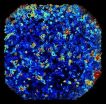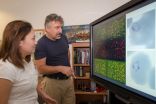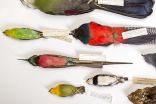"We've known for many years that the singing behavior of birds is similar to speech in humans -- not identical, but similar -- and that the brain circuitry is similar, too," said Jarvis, an associate professor of neurobiology at the Duke University Medical School and an investigator at the Howard Hughes Medical Institute. "But we didn't know whether or not those features were the same because the genes were also the same."
Now scientists do know, and the answer is yes -- birds and humans use essentially the same genes to speak.
After a massive international effort to sequence and compare the entire genomes of 48 species of birds representing every major order of the bird family tree, Jarvis and his colleagues found that vocal learning evolved twice or maybe three times among songbirds, parrots and hummingbirds.
Even more striking is that the set of genes involved in each of those song innovations is remarkably similar to the genes involved in human speaking ability.
The findings are part of a package of eight scientific papers in a Dec. 12 special issue of Science and 21 additional papers appearing nearly simultaneously in Genome Biology, GigaScience and other journals. Jarvis' name appears on 20 papers and he is a corresponding author for 8 of them.
Jarvis co-led the Avian Phylogenomics Consortium with Guojie Zhang of the National Genebank at BGI in China and the University of Copenhagen and M. Thomas P. Gilbert of the Natural History Museum of Denmark. His Duke lab contributed to preparing samples, sequencing and annotating the genomes, performing the analyses and coordinating the overall project.
The Jarvis lab in the Bryan Research Building prepared DNA of many of the species, pulling it from little chunks of frozen, pink bird flesh collected over the past 30 years by museums and other institutions around the world. To ensure the DNA being sequenced really belonged to the Golden-collared manakin and not an undergraduate lab assistant, the lab has been kept spotlessly clean and many of its tools are used only once, to avoid the possibility of subsequent contamination.
"We change gloves a lot," said Carole Parent, the lab research analyst who set up a DNA isolation pipeline for the next stage of the project to sequence still more birds and supervised sample prep with a team of Duke undergrads and a student from East Chapel Hill High School.
All of this meticulous and somewhat tedious work has given Jarvis and hundreds of colleagues around the world a crack at an unprecedented amount of genomic data generated by BGI in China. The whole-genome comparison of the 48 bird species required new algorithms written at the University of Illinois and University of Texas that ran for 400 years of CPU time on three supercomputers in the U.S.
Of the 29 papers covering everything from penguin evolution to color vision, eight are devoted to bird song.
One of the Dec. 12 papers in Science found there is a consistent set of just over 50 genes that show higher or lower activity in the brains of vocal learning birds and humans. These changes were not found in the brains of birds that do not have vocal learning and of non-human primates that do not speak, according to this Duke team, which was led by Jarvis; Andreas Pfenning, a graduate of the Ph.D. program in computational biology and bioinformatics (CBB); and Alexander Hartemink, professor of computer science, statistical science and biology.
"This means that vocal learning birds and humans are more similar to each other for these genes in song and speech brain areas than other birds and primates are to them," Jarvis said.
These genes are involved in forming new connections between neurons of the motor cortex and neurons that control the muscles that produce sound.
A companion study by another CBB doctorate, Rui Wang, looked at the specialized activity of a pair of genes involved in the regions of the brain that control song and speech. This study, appearing in the Journal of Comparative Neurology, found that these genes are down- and up-regulated in one brain region of song-learning birds during the juvenile period of their vocal learning , changes that last into adulthood. This study, and that of Pfenning, hypothesize that changes in these genes could be critical for the evolution of song in birds and speech in humans.
"You can find those same genes in the genomes of all species, but they're active at much higher or lower levels in the specialized song or speech brain regions of vocal learning birds and humans," Jarvis said. "What this suggests to me is that when vocal learning evolves, there may be a limited way in which the brain circuits can evolve."
Another paper in Science from Duke, led by post-doc Osceola Whitney, Pfenning, Hartemink and Anne West, an associate professor of neurobiology, looked at gene activation in different areas of the brain during singing. This team found activation of 10 percent of the expressed genome during singing, with diverse activation patterns in different song-learning regions of the brain. The diverse gene patterns are best explained by epigenetic differences in the genomes of the different brain regions, meaning that individual cells in different brain regions can regulate genes at a moment's notice when the birds sing.
Among the three main groups of vocal learning birds, parrots are clearly different in their ability to mimic human speech. Mukta Chakraborty, a postdoc in the Jarvis lab, led a project that used the activity of some of the specialized genes to discover that the parrot's speech center is organized somewhat differently. It has what the researchers call a "song-system-within-a-song-system" in which the area of the brain with different gene activity for producing song has an outer ring of still more differences in gene expression.
Parrots are very social animals, Chakraborty said, and having the ability to quickly pick up "dialects" of parrot speech may account for their super-charged speech center. The "shell" or outer regions were found to be proportionally larger in the parrot species, which are believed to have the highest vocal, cognitive and social abilities. These species include Amazon parrots, the African Grey and the Blue and Gold Macaw.
Jarvis was also part of a team with Claudio Mello and his Ph.D. student Morgan Wirthlin at Oregon Health & Science University that found ten more genes that are unique to song-control regions of songbirds. This paper appears in BMC Genomics.
A paper in Science led by Zhang, Gilbert and Jarvis found the genomes of vocal learners are more rapidly evolving and have more chromosomal rearrangements compared to other bird species. This genomic comparison also found similar changes occurred independently in in the song-learning area of different birds' brains.
Jarvis said knowing more of this history of how speech evolved in birds makes vocal learning birds even more valuable model organisms for helping to answer the questions he and other researchers are addressing about human speech.
"Speech is difficult to study in human brains," he said. "Whales and elephants learn speech and songs, but they're too big to house in the lab. Now that we have a deeper understanding of how similar birdsong brain regions are to human speech regions at the genetic level, I think they'll be a better model than ever."
Jarvis' general exploration of the bird brain over his 16 years at Duke has also led to several unexpected discoveries unrelated to song.
In 2005, he and colleagues found a center of the brain in migratory birds that apparently enables sensing of magnetic fields through "night vision." That year he also led a revision of the understanding of bird brain organization and vertebrate brain evolution. Last year, he led a re-drawing of the geography of the bird brain based on analysis of 52 genes that are active in 23 areas of the brains of eight species of birds. This new map shows neuron groupings in the birds' brains to be organized in columns like the brains of humans and other mammals.
He also branched out a bit and learned about the brain structures that enable mice to "sing" in ultrasonic ranges beyond human hearing.
Jarvis said this first wave of findings from the Avian Phylogenomics Consortium is just the beginning of an exciting new era of genomic analysis. The international group is already sequencing more birds at the whole-genome level.
"This is an exciting moment," said Jarvis, who is also a member of the Duke Institute for Brain Sciences. "Lots of fundamental questions now can be resolved with more genomic data from a broader sampling. I got into this project because of my interest in birds as a model for vocal learning and speech production in humans, and it has opened up some amazing new vistas on brain evolution."
INFORMATION:




